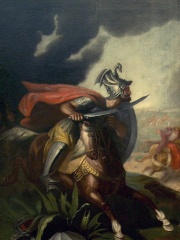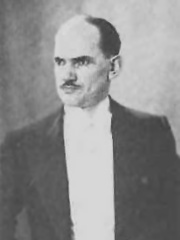

The Most Famous
MILITARY PERSONNELS from Kosovo
This page contains a list of the greatest Kosovar Military Personnels. The pantheon dataset contains 2,058 Military Personnels, 2 of which were born in Kosovo. This makes Kosovo the birth place of the 66th most number of Military Personnels behind South Africa, and Uzbekistan.
Top 2
The following people are considered by Pantheon to be the most legendary Kosovar Military Personnels of all time. This list of famous Kosovar Military Personnels is sorted by HPI (Historical Popularity Index), a metric that aggregates information on a biography's online popularity.

1. Miloš Obilić (1350 - 1389)
With an HPI of 74.29, Miloš Obilić is the most famous Kosovar Military Personnel. His biography has been translated into 35 different languages on wikipedia.
Miloš Obilić (Serbian Cyrillic: Милош Обилић, pronounced [mîloʃ ôbilit͡ɕ]) is a legendary Serbian knight and saint in the Serbian Orthodox Church traditionally said to have served Prince Lazar during the Ottoman invasion of Serbia in the late 14th century. Although absent from contemporary records, he features prominently in later accounts of the 1389 Battle of Kosovo as the assassin of Sultan Murad I. The assassin remains unnamed in historical sources until the late 15th century, but the widespread circulation of the story in Florentine, Serbian, Ottoman, and Greek sources suggests that versions of it were known across the Balkans within decades of the battle. His original name is believed to have been Miloš Kobilić, though multiple variations exist in historical sources, and his actual existence remains uncertain. The Lazar dynasty, consolidating its power, gave birth to the Kosovo Myth, which incorporated the legend of Obilić. Jelka Ređep notes that Obilić's legend significantly evolved through oral tradition, reflecting Serbian cultural ideals of heroism, loyalty and sacrifice. Over time, he became a central figure in Serbian epic poetry, where he was elevated to the status of a national hero embodying medieval Serbian folklore. Alongside Prince Lazar’s martyrdom and the alleged treachery of Vuk Branković, Miloš's deed became integral to Serbian narratives surrounding the Battle of Kosovo. By the 19th century, he was also venerated as a saint in the Serbian Orthodox Church. Miloš Obilić also appears in Albanian epic poetry, where he is remembered as Millosh Kopiliqi, with his birthplace traditionally linked to the Drenica region in modern-day Kosovo, where villages named Kopiliq still exist. However, there is no definitive evidence confirming the identity of Murad’s assassin.

2. Elyesa Bazna (1904 - 1970)
With an HPI of 65.02, Elyesa Bazna is the 2nd most famous Kosovar Military Personnel. His biography has been translated into 23 different languages.
Elyesa Bazna (Turkish: [ˈeljesa ˈbazna]), sometimes known as Iljas, Ilyaz and Iliaz Bazna (Albanian: [iljas bazna]; 28 July 1904 – 21 December 1970), was a secret agent for Nazi Germany during World War II, operating under the code name Cicero. In 1943, Bazna was hired as a valet by Hughe Knatchbull-Hugessen, the British ambassador in Ankara, Turkey. He photographed British documents in Knatchbull-Hugessen's possession, and sold them to the Germans through their attaché Ludwig Carl Moyzisch in what became known as the Cicero affair. As Cicero, Bazna passed on important information about many of the Allied leaders' conferences, including the Moscow, Tehran and Cairo Conferences. The details for the Tehran Conference were important for Operation Long Jump, the unsuccessful plot to kill Franklin D. Roosevelt, Joseph Stalin, and Winston Churchill. Bazna had also conveyed a document that carried the highest security restriction (BIGOT list) about Operation Overlord (the code name for the Invasion of Normandy in June 1944). It included intelligence that the British ambassador was to request the use of Turkish air bases "to maintain a threat to the Germans from the eastern Mediterranean until Overlord is launched." The information about the Normandy Invasion was not known by the Germans until after the war. Had it been provided in time, Operation Overlord (the preparations for D-Day) would have been compromised. He also provided intelligence that might have made the Germans believe that there was no danger of attack in the Balkans. The information that he leaked is believed to have been among the more damaging disclosures made by an agent during WWII. The German Foreign Office questioned the reliability of the intelligence provided by Cicero due to the large quantity of transmitted documents, which meant that apparently little, if any, of it was acted upon. It seems likely that he had received some intelligence training from the Italian secret intelligence service, SIM. This would explain much, for as Wilfred Dunderdale later stated, "We always thought Cicero was an Italian agent because of his modus operandi - they gave their agents special training in locksmithery and in infiltrating diplomatic households." After the war, Bazna lived in Ankara with his family for many years and obtained work doing odd jobs. Much of the money the Germans had paid him was revealed to be counterfeit. He moved to Munich in 1960 and worked as a night watchman before dying in 1970 of kidney disease. In 1962, Bazna published a memoir about the Cicero affair.
People
Pantheon has 2 people classified as Kosovar military personnels born between 1350 and 1904. Of these 2, none of them are still alive today. The most famous deceased Kosovar military personnels include Miloš Obilić, and Elyesa Bazna.

